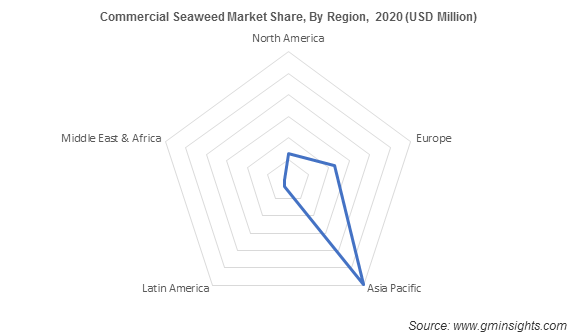Home > Food & Beverages > Proteins > Alternative Proteins > Commercial Seaweed Market
Commercial Seaweed Market Analysis
- Report ID: GMI1658
- Published Date: Jul 2021
- Report Format: PDF
Commercial Seaweed Market Analysis
Commercial seaweed market from brown seaweed segment generated around USD 20 billion in 2020. All brown seaweeds contains alginic acid or alginates, which are extensively utilized for several commercial applications and can be extracted from various brown algae, such Ascophyllum, Laminaria, and Macrocystis, among others. These acids are used in food products, such as ice cream in order to prevent ice crystallization and to achieve a smooth texture. Furthermore, the product finds application as a thickener and emulsifier in syrups, and as a filler in salad dressings and candy bars. The usage of alginic acid in lithium-ion batteries is anticipated to further drive the consumption of brown seaweeds in the coming years.

Commercial seaweed market from food industry is projected to surpass the annual demand of over 20.5 kilo tons by 2027. The segment includes direct food and food additives, which have been consumed as a staple food product in countries like Japan, Korea, and China. In Japan, seaweeds account for over 8% of the total diet, with consumption having witnessed around 20% growth over the last decade, reaching an average of 3.3 kg per household.
The animal feed segment is anticipated to exhibit high growth potential in the coming years. In coastal regions, seaweed is utilized as an animal feed additive in large quantities. It comprises a large number of necessary vitamins & minerals, such as phosphorous, potassium, magnesium, chlorine, calcium, sodium, and sulfur. Additionally, the growing need to mitigate climate change in conjunction with supportive government policies & initiatives will trigger biofuel production, thereby driving the commercial seaweed industry expansion.

Asia Pacific commercial seaweed market is expected to witness around 10% CAGR from 2021 to 2027. The use of seaweed as a food source in Asian countries, such as China, Japan, and the Republic of Korea has strong roots and is a key growth enabling factor for the increasing product demand in the region. In Asia Pacific, China remains the largest producer & consumer followed by Japan, South Korea, and Indonesia. Positive trends associated with the food industry triggered by a huge population are bound to boost the regional market statistics in the upcoming years.
Middle East & Africa commercial seaweed market is at nascent stage and will exceed USD 1 billion by 2027. The product is yet to attain extensive acceptance in the food sector. Increasing consumption of nutritious foods and changing consumer demographics will create demand for novel food ingredients & recipes.

